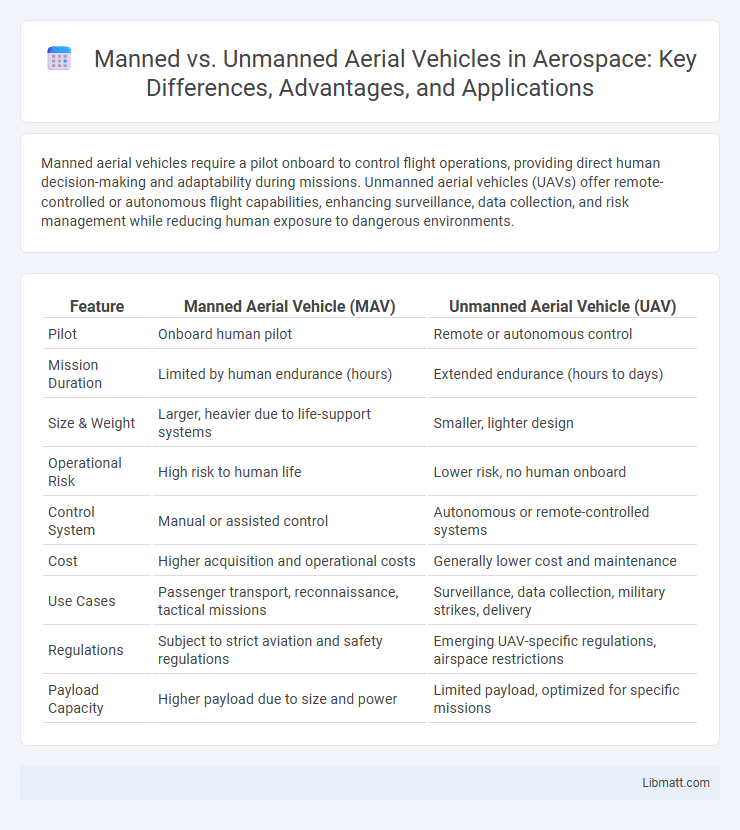Manned aerial vehicles require a pilot onboard to control flight operations, providing direct human decision-making and adaptability during missions. Unmanned aerial vehicles (UAVs) offer remote-controlled or autonomous flight capabilities, enhancing surveillance, data collection, and risk management while reducing human exposure to dangerous environments.
Table of Comparison
| Feature | Manned Aerial Vehicle (MAV) | Unmanned Aerial Vehicle (UAV) |
|---|---|---|
| Pilot | Onboard human pilot | Remote or autonomous control |
| Mission Duration | Limited by human endurance (hours) | Extended endurance (hours to days) |
| Size & Weight | Larger, heavier due to life-support systems | Smaller, lighter design |
| Operational Risk | High risk to human life | Lower risk, no human onboard |
| Control System | Manual or assisted control | Autonomous or remote-controlled systems |
| Cost | Higher acquisition and operational costs | Generally lower cost and maintenance |
| Use Cases | Passenger transport, reconnaissance, tactical missions | Surveillance, data collection, military strikes, delivery |
| Regulations | Subject to strict aviation and safety regulations | Emerging UAV-specific regulations, airspace restrictions |
| Payload Capacity | Higher payload due to size and power | Limited payload, optimized for specific missions |
Introduction to Manned and Unmanned Aerial Vehicles
Manned aerial vehicles are piloted aircraft requiring onboard human control, widely used for passenger transport, military missions, and aerial surveying. Unmanned aerial vehicles (UAVs), commonly known as drones, operate remotely or autonomously without a human pilot onboard, playing crucial roles in surveillance, agriculture, and disaster management. The evolution of UAV technology enhances capabilities such as real-time data collection and extended flight durations, transforming modern aerial operations.
Historical Evolution of Aerial Vehicles
The historical evolution of aerial vehicles spans from early manned balloons and gliders to modern unmanned aerial vehicles (UAVs) that revolutionize warfare and surveillance. Initially, manned aircraft dominated aviation advancements, with pioneers like the Wright brothers achieving powered flight in 1903. Today, UAVs leverage advancements in remote control, GPS, and AI, transforming aerial operations by offering enhanced precision and reduced human risk.
Key Differences Between Manned and Unmanned Systems
Manned aerial vehicles require a pilot onboard to control the aircraft, whereas unmanned aerial vehicles (UAVs) are remotely operated or autonomous, eliminating the need for onboard human presence. Manned systems offer direct human decision-making and adaptability in complex environments, while UAVs provide extended operational endurance, reduced risk to human life, and lower operational costs. Key differences include control mechanisms, mission duration capabilities, risk factors, and applications across military, commercial, and surveillance sectors.
Applications and Use Cases
Manned Aerial Vehicles (MAVs) are primarily used for passenger transport, cargo delivery, and complex reconnaissance missions requiring human judgment and adaptability. Unmanned Aerial Vehicles (UAVs) excel in applications like surveillance, agricultural monitoring, disaster assessment, and military targeting due to their remote operation and cost-efficiency. Your choice of vehicle depends on mission requirements, with UAVs offering advantages in risk reduction and continuous data collection.
Advantages of Manned Aerial Vehicles
Manned Aerial Vehicles (MAVs) provide pilot oversight, enabling real-time decision-making and adaptability during complex missions. These aircraft benefit from human judgment in dynamic environments, enhancing safety and mission success. Your operations gain from the direct control and situational awareness that manned aviation delivers.
Advantages of Unmanned Aerial Vehicles
Unmanned Aerial Vehicles (UAVs) offer significant advantages including enhanced safety by eliminating pilot risk in hazardous environments and cost-efficiency through reduced operational and maintenance expenses. Their ability to conduct long-duration flights without fatigue enables extensive surveillance and data collection for applications like agriculture, disaster management, and military operations. Your use of UAVs can also benefit from increased maneuverability and access to remote or difficult-to-reach areas where manned aircraft may face limitations.
Safety and Operational Challenges
Manned aerial vehicles face higher risks due to pilot exposure to hazardous conditions and the need for extensive training, while unmanned aerial vehicles (UAVs) mitigate pilot risk but encounter cybersecurity vulnerabilities and communication signal interference. UAVs require advanced remote control technology and fail-safe systems to address potential operational failures and latency in command execution. Both manned and unmanned systems impose unique safety protocols and regulatory challenges to ensure secure airspace integration and mission reliability.
Cost Comparison and Economic Impact
Unmanned Aerial Vehicles (UAVs) generally incur lower operational and maintenance costs compared to Manned Aerial Vehicles (MAVs) due to the absence of pilot-related expenses, such as training and life-support systems. The economic impact of UAVs includes significant cost savings in industries like agriculture, surveillance, and logistics by enabling longer flight durations and reducing human risk. However, MAVs still dominate sectors requiring complex decision-making and adaptability during missions, balancing higher costs with operational flexibility.
Regulatory and Legal Considerations
Manned and unmanned aerial vehicles (UAVs) face distinct regulatory frameworks, with piloted aircraft governed by comprehensive aviation authorities like the FAA and EASA, emphasizing pilot certification and airworthiness. UAVs, especially drones, are subject to evolving regulations addressing remote operation, airspace integration, and privacy concerns, often requiring compliance with specific operational limits and registration mandates. Liability and accountability differ significantly, where manned flights place responsibility on onboard pilots, while unmanned operations raise complex issues involving remote operators, manufacturers, and potentially automated system controls.
Future Trends in Aerial Vehicle Technology
Future trends in aerial vehicle technology emphasize advancements in autonomous systems, enhancing the capabilities of unmanned aerial vehicles (UAVs) with improved AI-driven navigation, real-time data processing, and extended flight endurance. Integration of hybrid power sources and lightweight materials promises to increase the efficiency and range of both manned and unmanned aerial vehicles (MAVs and UAVs). Enhanced communication networks, including 5G and satellite connectivity, will enable seamless coordination between manned and unmanned platforms in complex airspace environments.
Manned vs Unmanned Aerial Vehicle Infographic

 libmatt.com
libmatt.com